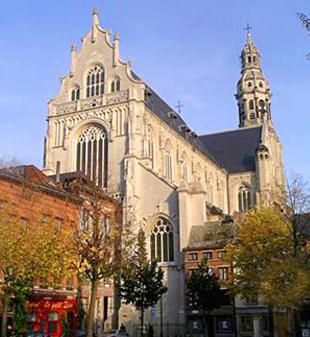Saint Paul's Church Antwerp

In 1276, twenty years after establishing themselves on land held by one Hugo Nose, the Dominicans were permitted by their renowned fellow friar and priest Albertus Magnus to consecrate a first small church within the new city ramparts. In the 16th century, it was decided to build a larger church with a greater elevation at ground level in order to prevent flooding from the Scheldt. Following the troubles of the Protestant Reformation, having withstood expulsion and Calvinist purges, the friars set to work once again from 1585 onwards. Firstly, they renovated the then church. Next, in 1618 - at the height of the baroque - they continued to build the transept and the immense choir in the traditional Gothic style over a period of some twenty years. Since the baroque interior decoration here has been so wonderfully reconciled with the Gothic architecture, St. Paul's Church has been referred to as ‘a baroque jewel in a Gothic shrine'.
Artwork is on display here in the form of a series of paintings depicting fifteen mysteries of the rosary, the responsibility for which fell to some ten painters, including Hendrik Van Balen I, Cornelis De Vos and Antwerp's three grandmasters, Rubens, Jordaens and Van Dyck. Not only did a connection exist between Rubens and Antwerp's Dominicans in terms of artistic expression but also in terms of inner confession. It is a fact that Rubens chose Prior Michaël Ophovius as his personal confessor.
Even more abundantly in evidence is the sculpture: altars and communion rails, choir stalls and the organ, epitaphs and portals. The confessionals alone contain 40 life-size figures and, moreover, were created using lavish panel work. As if that were not in itself enough, there is also a sculpture garden resembling an open-air theatre, showcasing the extraordinary expertise of masters such as Artus Quellinus II, Peter Verbrugghen the Elder and Younger, and Willem Kerricx.
After the fire of 1679, the baroque tower with its double lantern replaced the destroyed commemorative tower by N. Millich: an exceptionally imposing structure for a church of this mendicant order.
The end of the 18th century meant new misfortune, albeit in the name of the Enlightenment. First of all, in 1781, the covetous eye of the Austrian Holy Roman Emperor, Joseph II, fell on The Madonna of the Rosary by Caravaggio. Afterwards, in 1796, a definitive end came to the Dominicans' community due to closure of the monastery by the French revolutionaries and their public sale of the church. Some of the major paintings, including one by Rubens, had already left the church and found their way to the central depository in France.
Prior Peltiers succeeded in buying back the church and the monastery. Following the Concordat of Pope Pius VII with Napoleon in 1801, the City subsequently bought the church to replace the former, dilapidated parish church of Sint-Walburgis next to Het Steen. The adaptation from monastery to parish church in 1833 did have the result of the baroque choir rood loft being demolished in order to create a splendid perspective of depth to the presbytery with the monumental high altar.
CC BY (Creative Commons 4.0)
